 |
Ace Your Exercise and Nutrition Science Project: Great Science Fair Ideas Robert Gardner Part of the “Great Science Fair Ideas” series that also includes chemistry, food science, space science, animal science, human biology, plant sciences, and exercise/nutrition titles, this book is filled with terrific science project ideas. A brief introduction sets a welcome tone implying that all of us are scientists all the time, and an effort has been made to dispel the “mad scientist” image that permeates many science fair books. A short section on the scientific method is followed by an explanation of what science fair judges are looking for, how to be a responsible science fair participant, and what safety precautions students should follow. When an adult should be involved, there is a notation at the beginning of the list of materials and a red bolded text inside the body of the experiment’s narrative. Chapters include “Defining and Assessing Good Health” (experiments include measuring heart rate, breathing rate, blood pressure, and body temperature); “The Effects of Body Position, Exercise, and Conditioning” (explorations into relationships between exercise and various body functions measured in chapter one); “Metabolism and Nutrition” (measuring BMR, diets to meet energy needs, food labels, measuring daily calcium requirement); “Eating Habits to Maintain a Healthy Weight” (what is your BMI, measuring density of various kinds of milk, comparing nutritional values, measuring ingredients in food); and “Vitamins and Other Health Products” (how to determine vitamin C content, how sunscreen works, antibacterial hand lotion, how does toothpaste work, which shampoo works better). A page of “Further Reading and Internet Addresses” is followed by a short index. Unlike many of the science project books you will find on library shelves, this one does not tell kids what the outcomes are supposed to be. HOORAY AND HALLELUJIAH!!!! In my world, if you know how an experiment is supposed to turn out, then it is not an experiment but a demonstration or a magic trick. This title guides the reader to design good experiments that narrow down the variables to one and encourages them to repeat and vary the experiments to validate their hypotheses. Throughout the book, readers will want to have their own three by five notecards handy to jot down questions that will inspire new science projects, because it is almost guaranteed every page will spawn at least three new possibilities. This book has 128 pages. The illustrations are clear and easily understood and themselves will inspire readers to use charts, graphs, and illustrations of their own in science projects they set up. Many challenging math calculations are included in some of the experiments which will delight calculator-loving kids. Altogether one of the best books for science fair we have seen. Colorful pages, attractive headers of various colors, and nicely formatted pages will entice older readers to enjoy science and enable younger readers to reach up and do real science! 2010, Enslow Publishers, Ages 10 up, $31.93. REVIEWER: Gwynne Spencer (Children’s Literature). ISBN: 9780766032187 |
 |
Body Fuel: A Guide to Good Nutrition Donna Shryer Nutrition is an art and a science. It takes creativity to keep foods interesting and appealing, and it takes knowledge to understand what foods are best for the body. A nutritious diet provides the body with the power and energy it needs. The body also requires nutrients in order to grow, repair itself, and recover from illness. The body produces some of these nutrients on its own. The rest come from food and are called essential nutrients. There are six essential nutrients: carbohydrates, proteins, fats, water, vitamins, and minerals. Carbohydrates (carbs) are the first nutrients digested. They pretty much power the entire body. Some carbs are “simple” and some are “complex.” Simple carbs are found in candy, soda, etc. Complex carbs are in cereal, bread, and pasta. They take longer to break down, so they supply steady energy over long periods of time. Protein is an important part of living cells. Proteins that come from animal sources are called complete proteins. Fats are essential in the diet, but there are good fats and bad fats. Water is everyone’s friend, and is essential to good health. Water accounts for at least sixty percent of total body weight, so it is important to maintain that percentage. Otherwise, dehydration can occur, which can cause headaches, fatigue, and loss of concentration. Vitamins and minerals play an important part in diet. Vitamins come from living things such as fruits, vegetables, and animals. Minerals come from nonliving sources such as soil, rocks, or water. The purpose of a nutritious diet is to give the body the nutrients and energy it needs to enjoy life. When it comes to nutrition, be creative, be clever, and be careful. The colorful pictures in the book help illustrate the importance of good nutrition. There is a glossary in the back to look up words that may be hard to understand. 2010, Marshall Cavendish Corporation, Ages 8 up, $19.95. REVIEWER: Beverly Melasi (Children’s Literature). ISBN: 9780761443629 |
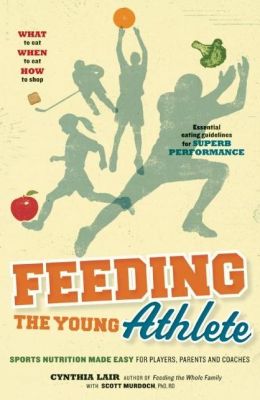 |
Feeding the Young Athlete: Sports Nutrition Made Easy for Players, Parents and Coaches Cynthia Lair and Scott Murdoch With so much partial and misinformation available through the internet for young athletes, there is finally a common sense, informational book written for them in simple language. Lair, a certified health and nutrition counselor is an assistant professor in the Nutrition and Exercise Science Department at Bastyr University. She has partnered with Scott Murdoch who has a doctorate in nutrition and human performance. Together they explain what young athletes should be eating for practices, and before and after games. Lair and Murdoch make a strong case for young athletes to eat real food. They offer recipes for breakfast, pack-n-go snacks and “winning pregame meals.” The layout is inviting. There are many boxes with quickly gleaned information, yet the pages never look crowded. Teens will probably begin by glancing at this book, but soon they will want to read it from cover to cover. Athletes are always trying to achieve their best. They know there is a relationship between what they eat and how they perform. Here is a book that is very accessible. Every library should own this book, display it and recommend it for teens, their parents, and coaches. 2012, Readers to Eaters Books, Ages 12 and up, $12.95. REVIEWER: Sharon Salluzzo (Children’s Literature). ISBN: 97809836615-2-8 |
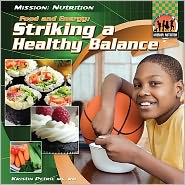 |
Food and Energy: Striking A Healthy Balance By Kristin Petrie One of the “Mission: Nutrition” series designed for upper elementary students, this title discusses the relationship of food and nutrients to growing bodies, how to find a balance among all the foods we eat, how to read food labels, controlling serving size, guarding one’s health by monitoring intake and the value of exercise to a healthy body. Color photos, boxed information and highlighted vocabulary accompany the short chapters. The well-researched and up to date text is just enough information to alert young people to the fact that you are what you eat as well as the importance of exercise to overall health and body weight. One chapter introduces the Let’s Move program initiated by First Lady Michelle Obama as well as briefly reviewing the points in the book. Increased childhood obesity makes it imperative that young people become informed about making healthy choices. Highlighted new vocabulary is defined in a glossary. An index and web sites for more information are included. It is a nice balance of information in an interesting format. 2012, ABDO Publishing Co, Ages 8 to 10, $17.95. REVIEWER: Meredith Kiger, Ph.D. (Children’s Literature). ISBN: 9781617830808 |
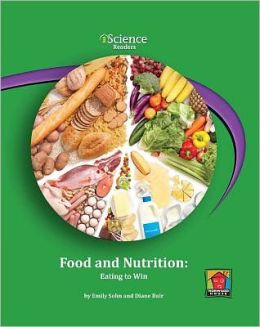 |
Food and Nutrition: Eating to Win Emily Sohn and Diane Bair The authors present a hypothetical situation: What if you owned a restaurant and thousands of people were coming to your town to run in a race? The runners need good food and nutrition in order to run a good race. What will you serve them to keep them strong and full of energy? Four food menus are possible, and the owner must decide which one is the best choice. It is now up to the reader to solve this science puzzle by learning about healthy foods and what kinds of food the body needs to run a race. In order to do this, the reader needs to learn about the Food Guide Pyramid, the importance of protein, carbohydrates and good fats. The reader also is informed about foods to avoid such as too much sugar and bad fats that can cause blocked heart arteries. In addition, the reader needs to know about vitamins and minerals and what kinds of food will meet their vitamin requirements. Other topics examined are the digestive and circulatory systems. Once the reader has the information he needs to choose the best menu for runners, he is asked to look at the pros and cons of each and utilizing critical thinking skills, choose the best selection based on the information that has been presented in the book. Many illustrations are included, as well as a glossary, further reading, additional notes, and index. 2011, Norwood House Press, Ages 9 to 12, $23.94. REVIEWER: Della A. Yannuzzi (Children’s Literature). ISBN: 9781599534244 |
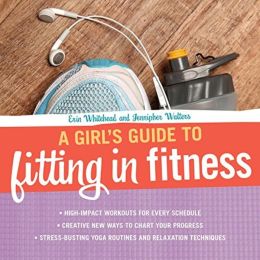 |
A Girl’s Guide to Fitting in Fitness Erin Whitehead and Jennipher Walters Anyone following current events is aware of the obesity epidemic facing our nation. Add to this the constant barrage of skinny models and actresses, it’s no wonder girls today have body issues. The authors of this book hope to give a balanced vision of health that includes good nutrition, proper exercise and a positive attitude. The advice they give is practical, especially considering teenagers do not have control over grocery shopping or transportation. Examples of exercises require no equipment, and recommended foods would be easy to find and easy to convince parents to buy. An entire chapter is devoted to fitness at school, encouraging girls to take extra PE classes and wear a pedometer to monitor how many steps taken during the school day. They even offer tips on how best to navigate the school lunch menu (although the advice might still be hard to follow in some cafeterias). Throughout the book, the idea of a positive attitude and self-image reappears often. For example, girls are encouraged to keep track of how they feel during a workout so they can see progress without having to look at a scale. The illustrations support this by using drawings of healthy girls rather than photos of a real person girls might compare themselves to. This is a well-written and practical guide to fitness for girls in middle and high school. 2013, Zest Books, Ages 12 up, $12.99. REVIEWER: Heather Robertson Mason (Children’s Literature). ISBN: 9781936976300 |
 |
Keeping Kids Fit: Proven Methods For Raising Strong, Active, Healthy Children Len Saunders All parents want their children to have long, healthy lives, which mean making wise choices about things like nutrition and physical activity. Growing up in a fitness-minded household provides the foundation necessary to develop a healthy lifestyle at home and at school. Most health organizations suggest that children need sixty minutes of physical activity each day to stay healthy. One way to accomplish this is to be part of a sports team at school. Being part of a team helps kids be physically active, cheerful, and healthy. Sports can also improve social skills, reduce stress, improve cognitive skills, and keep children busy. Children look to their parents for strength and inspiration. When parents get involved in their children’s sports, they can help nurture their child by showing them that it playing the game fairly is what counts; not whether they win or lose, but how they play the game. Fitness-minded parents know that outside exercise is a great way to spend time with the family. Taking a walk in one’s own neighborhood can be something the entire family can enjoy. Or perhaps a family bike ride. If the weather is poor outside, a local gym like the YMCA offer discounts if the whole family signs up. This book offers many great ideas for families to spend time together getting fit. It has great pictures of exercises that are easy for kids to do, with strategies to get them to do it. Proper nutrition and healthy snacking are briefly covered and where to find each in food. Recipes are included with tips for healthy meals that can be prepared at home. 2010, LaChance Publishing LLC, Ages 8 up, $15.95. REVIEWER: Beverly Melasi (Children’s Literature). ISBN: 9781934184264 |
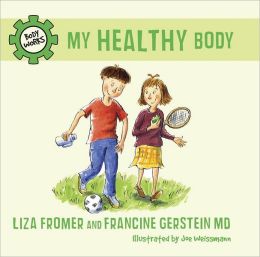 |
My Healthy Body Liza Fromer My Healthy Body and My Itchy Body are 2 books in a series of six in the Body Works Series that help children learn about their bodies. My Healthy Body covers the basics: sleep, exercise, nutrition, vaccines, eye and dental care, emotional health, learning, and hygiene. My Itchy Body talks about the various reasons your skin might be itchy such as simple dry skin, atopic dermatitis, hives, infection, lice and stress. The facts presented are clear and easy to understand, and the illustrations are bright, expressive, and often humorous. Scattered throughout the books are “Fun Facts” about health, “True or False” questions, and “Doctor Says” tidbits of advice. Medical terms explained in the text are designated with an “MT”, and the books contain a short glossary. Other books in the series include My Achy Body, My Messy Body, My Noisy Body, My Stretchy Body. 2012, Tundra Books, Ages 7 to 11, $14.99. REVIEWER: Susan Prior (Resource Links). ISBN: 9781770493124 |
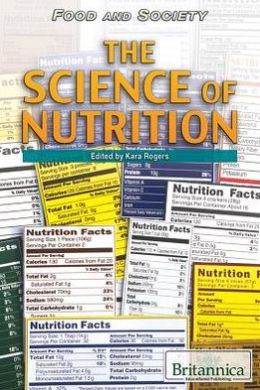 |
The Science of Nutrition Edited by Kara Rogers With the national and international focus on wellness and healthy living, The Science of Nutrition is indeed a timely book. In nine chapters, there are an array of topics aligned with the influence of nutrition in our daily lives. Background information with colorful illustrations and concise biographies of pioneers (nutritionists, biochemists, and physicians) reveal the relationship between food and the human body. In addition, the role that nutrition plays in the prevention and control of diseases is thoroughly explored. Beginning with a thorough overview, readers embark on a journey that provides factual details on how food is used in the body. Dietary guidelines that have been developed over the years in several countries are reviewed. An interesting discussion deals with nutritional needs during different stages of our life cycle (infancy- childhood-adolescence-adulthood) that affect to a large degree the quality of life. This journey continues with an in-depth presentation of the composition and sources of six essential food groups (carbohydrates, lipids, proteins, vitamins, minerals, and water). It is of interest to note that water is perhaps the most important nutrient and that some nutrients are needed only in trace amounts. A detailed discussion explains the role that each nutrient plays in vital metabolic processes. Additionally, a classification of foods into nine groups (cereals, starchy roots, legumes, vegetables and fruits, sugars, preserves and syrups, meat, fish, eggs, milk and milk products, fats and oils, and beverages) is depicted. Emphasis is placed on the fact that knowledge of these groups and factors that influence food intake such as culture and religion are crucial in maintaining a balanced diet. Also, nutritional irregularities such as malnutrition, mineral deficiencies/toxicities, and dehydration are brought to the forefront. Vitamins needed for vital biochemical processes must be obtained from the diet or synthetic sources. A detailed discussion about each vitamin (A, B, C, B complex, D, E, and K) including familiar names such as niacin, ascorbic acid, and riboflavin, is provided. Properties, sources, value, and deficiencies such as scurvy, rickets, and beriberi are also included. It is amazing to learn that the lack of one vitamin can automatically affect how others function. Moreover, it is also important to understand that on the one hand too much can be toxic and on the other hand too little can cause a deficiency. Contributions by Sir Frederick Gowland Hopkins, Adolf Windaus, and James Lind are highlighted. Additional topics described include vitamin-like substances and methods used to analyze vitamin content. It is interesting to discover how the term “home economics” was adopted. The correlation of the food we eat to a number of diseases has been well documented. Details explaining how diet affects cardiovascular diseases and many kinds of cancer are presented. Heredity, age, sex, and hormones are additional risk factors that are believed to contribute to these diseases. The exposition on diabetes focuses on diet, obesity, symptoms, causes, and treatment. It is noteworthy to learn that diabetes affects many vital organs and is prevalent among specific ethnic groups. Other disorders described are gastrointestinal disorders, tooth decay, and eating disorders such as anorexia nervosa. Additional risk factors explored are sunlight, biological and chemical agents and water pollution. This journey ends with a dialogue on the impact of environmental factors on our food supply. A concise review of initiatives that have been developed and are being developed to prevent food-borne diseases due to contamination by a variety of organisms, agents, and unsanitary conditions is presented. Pertinent facts related to food and drug interactions, food allergies, and toxins are also delineated. In the appendix, readers will find tables on vitamins, a nutrient scoreboard, common food-borne illnesses, a glossary, bibliography, and index. This is a comprehensive resource and is recommended for health professionals and anyone interested in pursuing a healthier lifestyle. 2013, Rosen Publishing Group, Ages 14 to 18, $45.00. REVIEWER: Jean Worsley (National Science Teachers Association (NSTA)). ISBN: 9781615309207 |
 |
Sports Nutrition for Teen Athletes: Eat Right to Take Your Game to the Next Level Dana Meachen Rau Playing sports takes a lot of energy. Whether on a rink, road, mat, field, court, or slope, athletes must exert energy. There are two types of exercise: aerobic and anaerobic. Aerobic exercise keeps the heart pumping over a long period of time using continuous movement, such as biking, dancing and running. Anaerobic exercise uses short bursts of energy. Sports using anaerobic exercise include track, gymnastics and martial arts. The body burns a lot of calories when doing any kind of sport or exercise. It requires nourishment to help replenish red blood cells, skin cells, nerve cells and muscle cells. These cells need food to do their job. Scientists measure how much energy there is in a food using calories. The number of calories each person needs depends on the person’s age, size and gender. Rau does a great job using large, vivid photographs to explain how nourishment and hydration have a huge impact on making one’s energy last. The words and easy-to-read sentences make this book a fun read. It is an interesting book for children and parents to read together. The book is a great way for teen athletes to learn how to nourish and replenish their bodies to improve athletic performance. 2012, Capstone Press, Ages 8 up, $31.32. |
 |
Weighing in: Nutrition and Weight Management The four books in this Food and Fitness series are clearly written guides to the role of food and nutrition, with a particular emphasis on teenagers. In Body Fuel, the author explains about how the body uses fat, protein, and carbohydrates; lets readers know which foods are healthier; and discusses vitamins and minerals. Shryer discusses the amounts and proportions people-particularly growing adolescents-need to keep healthy. Weighing In covers some of the same ground with an eye toward getting to and maintaining a healthy weight by eating healthy and getting enough exercise. The author warns readers away from fad diets with sound information about their effects on the body and why these methods do not keep the weight off. Both books take information than can be found easily on the Web and put it together into book form. There are helpful tips given throughout each title. Appendixes include charts for recommended intakes, as well as helpful further information (like some of those free Web sites from reputable agencies). Photos are stock. If the budget allows, these books, which also include titles on sports nutrition and eating disorders, will be useful for students who need everything laid out for them in very simple language. 2010, Marshall Cavendish Corporation, $19.95. REVIEWER: Alice F. Stern (VOYA). ISBN: 9780761443674 |
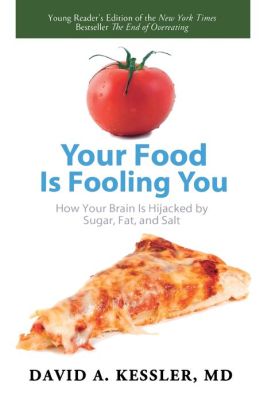 |
Your Food is Fooling You: How Your Brain is Hijacked by Sugar, Fat, and Salt David A. Kessler ; adapted by Richie Chevat In this young reader’s edition of Kessler’s The End Of Overeating (Rodale, 2010), the author reinforces the simple principle that eating too much can cause obesity. He continues to explain how restaurants and food manufacturing companies create products that are full of sugar, fat, and salt, which “hijack” people’s brains when eaten. This causes consumers to crave more of the unhealthy foods and eat them to excess. Kessler breaks down his findings using examples from popular chain restaurants, and concludes the book with “Food Rehab,” where he offers ways to overcome food challenges. While his points are often repetitive, the writing style certainly asserts Kessler’s thesis: that sugar, fat, and salt affect the chemistry of the brain so that those who consume these products become addicted to unhealthy foods and proceed to overeat them. Teens may get tired of this restatement throughout the chapters, but the information about the contents of restaurant food is interesting and makes it relatable. A huge plus is the section that lists simple behaviors to put into practice for those battling the overeating addiction. Kessler also reinforces the premise that eating is healthy and not something to feel guilty about; it is just overeating the wrong foods that causes excessive weight gain and health problems. Pair this title with books like Eat This, Not That by David Zinczenko (Rodale, 2007) and the memoir Hungry by Allen Zadoff (De Capo Lifelong, 2007). 2012, Roaring Brook, Grades 8 to 12, $9.99. REVIEWER: Deena Viviani (VOYA). ISBN: 9781596438316 |
Sports, Fitness, and Nutrition
 |
More and more we recognize the importance of being fit and healthy. Diet, exercise, and sleep can help us feel and look better, have more energy, and enhance performance. Whether through organized sports or personal discipline, good habits need to be formed. Take a look at these books to kick-start your reading on this vital topic.
Web links to additional information and activities about sports, nutrition, and fitness follow these reviews. Contributor: Peg Glisson |
Reviews
|



